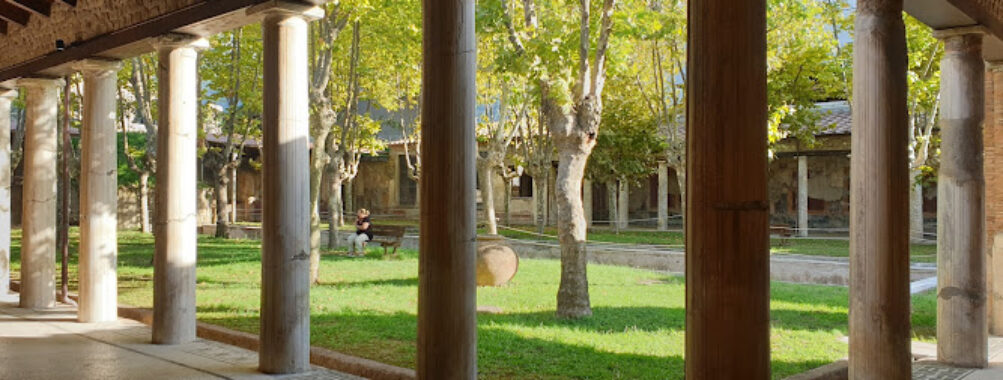
Scavi di Stabia – Villa San Marco
Table of Contents
Description
Perched along the ancient Bay of Naples coastline, Villa San Marco stands as one of the most impressive archaeological treasures within the Scavi di Stabia complex. I’ve visited countless Roman villas across Italy, but this one genuinely took my breath away. The sprawling 11,000-square-meter estate offers an intimate glimpse into the luxurious lifestyle of wealthy Romans before Mount Vesuvius dramatically halted life here in 79 AD.
The villa’s perfectly preserved frescoes are simply mind-blowing – their vivid colors and intricate details make it feel like the artists just finished painting them yesterday. The second-style Pompeian wall paintings are particularly remarkable, featuring trompe l’oeil architectural elements that fooled even my eyes at first glance.
Key Features
• Stunning two-story portico overlooking the Bay of Naples with original marble columns
• Exceptionally preserved thermal baths complex with hot and cold pools
• Elaborate garden courtyard (viridarium) surrounded by painted colonnades
• Magnificent triclinium (dining room) with detailed mythological frescoes
• Private quarters featuring bedroom suites with sea views
• Original mosaic floors in various geometric patterns
• Sophisticated water collection and distribution system
• Servant quarters and kitchen areas showing daily Roman life
• Well-preserved lararium (household shrine) with religious artwork
• Multiple reception rooms decorated with second and third-style Pompeian frescoes
Best Time to Visit
From my experience, spring (April-May) and fall (September-October) offer the most pleasant conditions for exploring Villa San Marco. The temperatures hover around 70°F (21°C), making it comfortable to wander through the uncovered portions of the site. Summer months can be brutally hot, and the lack of shade in some areas can make extended viewing challenging.
I’d recommend visiting early in the morning, right when they open. That’s when you’ll catch the most dramatic lighting for photos, and you’ll likely have many rooms to yourself. The site tends to get busier after 11 AM when tour groups from nearby Pompeii start arriving.
How to Get There
Getting to Villa San Marco requires a bit of planning, but it’s totally worth the effort. The nearest train station is Castellammare di Stabia, which you can reach via the Circumvesuviana line from Naples or Sorrento. From there, you’ve got a couple options.
You can catch a local bus (numbers vary by season) that stops near the archaeological site, but honestly, I’d recommend grabbing a taxi or using a ride-sharing service – it’s much more straightforward and takes about 10 minutes. If you’re driving, there’s a small parking area near the entrance, though it fills up quickly during peak season.
Tips for Visiting
Having explored this magnificent villa multiple times, I’ve picked up some handy tricks to make your visit more enjoyable. First off, wear comfortable shoes with good grip – some of the ancient floors can be slippery, and you’ll be doing quite a bit of walking.
Bring water and snacks because there aren’t many facilities on site. I learned this the hard way during my first visit! A hat and sunscreen are essential, especially during summer months. The site has limited shade in some areas.
Photography is allowed, but flash isn’t – and trust me, you’ll want to take lots of pictures. The morning light creates amazing shadows that really bring out the details in the frescoes.
Consider hiring a guide or getting an audio tour. There’s so much fascinating history here that’s easy to miss without some expert insight. I once walked right past what turned out to be an incredible example of Roman engineering in the water system because I didn’t know what I was looking at!
The site isn’t as crowded as Pompeii or Herculaneum, which makes it perfect for those who want a more intimate experience with ancient Roman architecture. You can actually spend time examining details without feeling rushed.
Oh, and don’t forget to check the opening hours before you go – they can vary by season. It’s also worth noting that some areas might be closed for restoration work. The ongoing preservation efforts mean there’s always something new to discover with each visit.
Lastly, combine your visit with the nearby Villa Arianna for a fuller understanding of how the Roman elite lived in this area. The two villas complement each other beautifully, and you can easily see both in one day.
Location
Places to Stay Near Scavi di Stabia - Villa San Marco
Find and Book a Tour
Explore More Travel Guides
No reviews found! Be the first to review!